
A 4WD touring adventure can take you to some of Australia’s most remote and stunning landscapes. With the marine wonderland of the Great Barrier Reef, an epic journey to the tip of Australia, and the red earth and vast blue sky of the brilliant Outback, a North Queensland road-trip more than fits that bill when it comes to the ultimate driving experience.
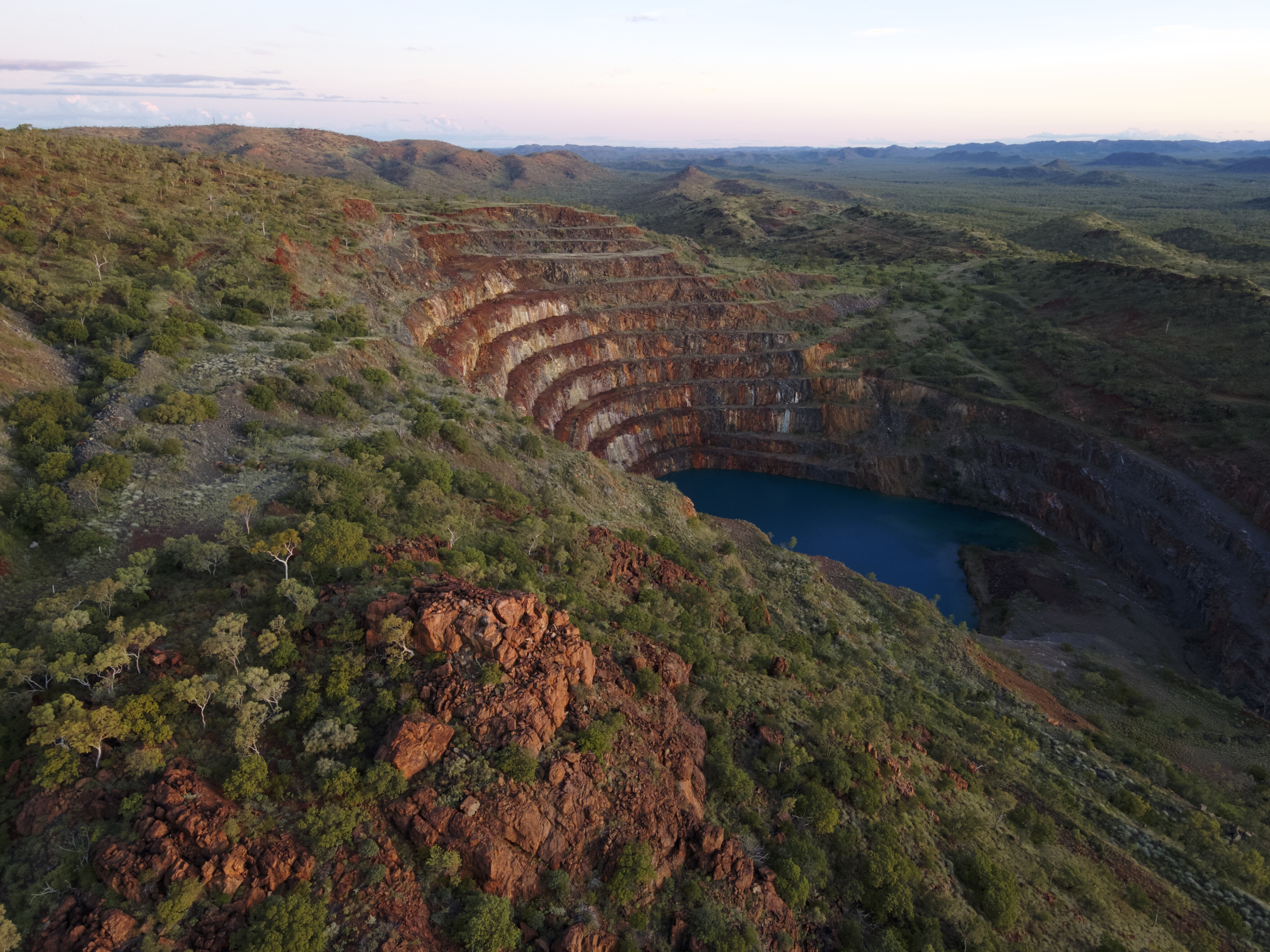
JUMP AHEAD
- The Savannah Way
- Overlanders Way
- North Queensland Wildlife Tracker
- Adventures in The Whitsundays
- The Mining Trail
The Savannah Way
For 4WD touring families there are certain road trips that are essentials on any bucket-list, and The Savannah Way most definitely qualifies. Traversing three states and territories, as it crosses the entire continent, and over a total distance of 3699km (of which 1099km is in North Queensland), the Savannah Way is unparalleled as a road trip that provides one hell of a life memory.
This epic route is relatively easy, with some side-tracks that suit more experienced four-wheel drivers. In terms of a vehicle, a well set-up 4WD tourer is the go; you don’t want to miss out on exploring any off-road side-tracks.
Five Highlights of North Queensland – Dick Eussen
How do you choose five ‘favourites’ from a destination that offers, literally, hundreds of memorable locations and moments for 4WD tourers? Well, it ain’t easy, but here’s five non-negotiable, must-visit spots for any North Queensland road trip.
- The Wet Tropics: The true tropics commence north of Townsville where the Bruce Highway tracks under imposing mountain ranges, pass palm-clad beaches, rainforests and mangroves, part of the Wet Tropics World Heritage Area which encompasses 894,420ha and extends from Townsville to Cooktown in an unbroken line for some 450 km.
It’s a stunning landscape that includes the rainforest-clad coastal ranges (the second highest coastal range in Australia), open forests, woodlands, wetlands, mangrove inlets and swamps.
- The Cape York Peninsula: Regarded as one of Australia’s best 4WD trips, ‘The Cape’ sits high on the bucket-list of 4WD travellers. With great camping, fun creek crossings, refreshing swimming holes and the end-goal of reaching Australia’s northernmost point, it’s deserving of its iconic status.
There are numerous ways to get there, to the point where it’s nearly ‘Choose your own adventure’. And it doesn’t matter which way you end up opting for – they’re all equally memorable.
- The Gulf Country: It's huge, and if you venture onto the more remote tracks, the Gulf Country is truly wild and woolly. Starting from the east in Cairns, onto the Savannah Way, visit the Hot Springs at Mount Garnett, Lava Tubes at Mount Surprise, Gobbold Gorge at Forsyth and the Tallaroo Hot Springs near Georgetown and Croydon’s historic town precinct and other attractions en route.
- Cloncurry – Mount Isa Region: Ranging north-west from Winton and Boulia are semi-desert hills, gorges, outcrops and escarpments that are beautiful beyond description. Both Cloncurry and the Isa have all you need from accommodation, tours and attractions to food and supplies.
Key attractions include Outback at Isa, Riversleigh Fossil Discovery Centre, and tours of the underground Hard Times Mine. In Cloncurry don't miss the John Flynn Place Museum, and nearby Chinaman Creek Dam for swimming, fishing and water sports.
Plus, there is the bonus of old mining, and water impoundments, where you can camp for free for weeks on end, while Lake Moondarra at Mount Isa has some of the biggest barramundi anywhere. North is Lake Julius, which has fine fishing for sooty grunter, and an amazing walk into the Impassable Gorge below the dam.
- The Starkey Track: This amazing track extends north from Cooktown to the Cape Melville and Rinyirru national parks. It’s the most scenic route on the Cape with patches of rainforest, waterfalls, and abandoned mining settlements.
The track is maintained as far as the Starkey River, there is a boat ramp and camp area on the mouth of the river. Melville N/P has high escarpments, stony ranges and outcrops that are similar to the Black Mountain Range south of Cooktown, apart from the colour as unlike the Black Mountain rocks no lichen covers them.
En route visit lovely Ninian Bay, a hidden cove where camping, fishing and bushwalking are all on offer. The Starkey Track junctions with the Kalpower Track at abandoned Wakooka Station, from there you turn towards Rinyirru and the Musgrave Roadhouse on the PDR.
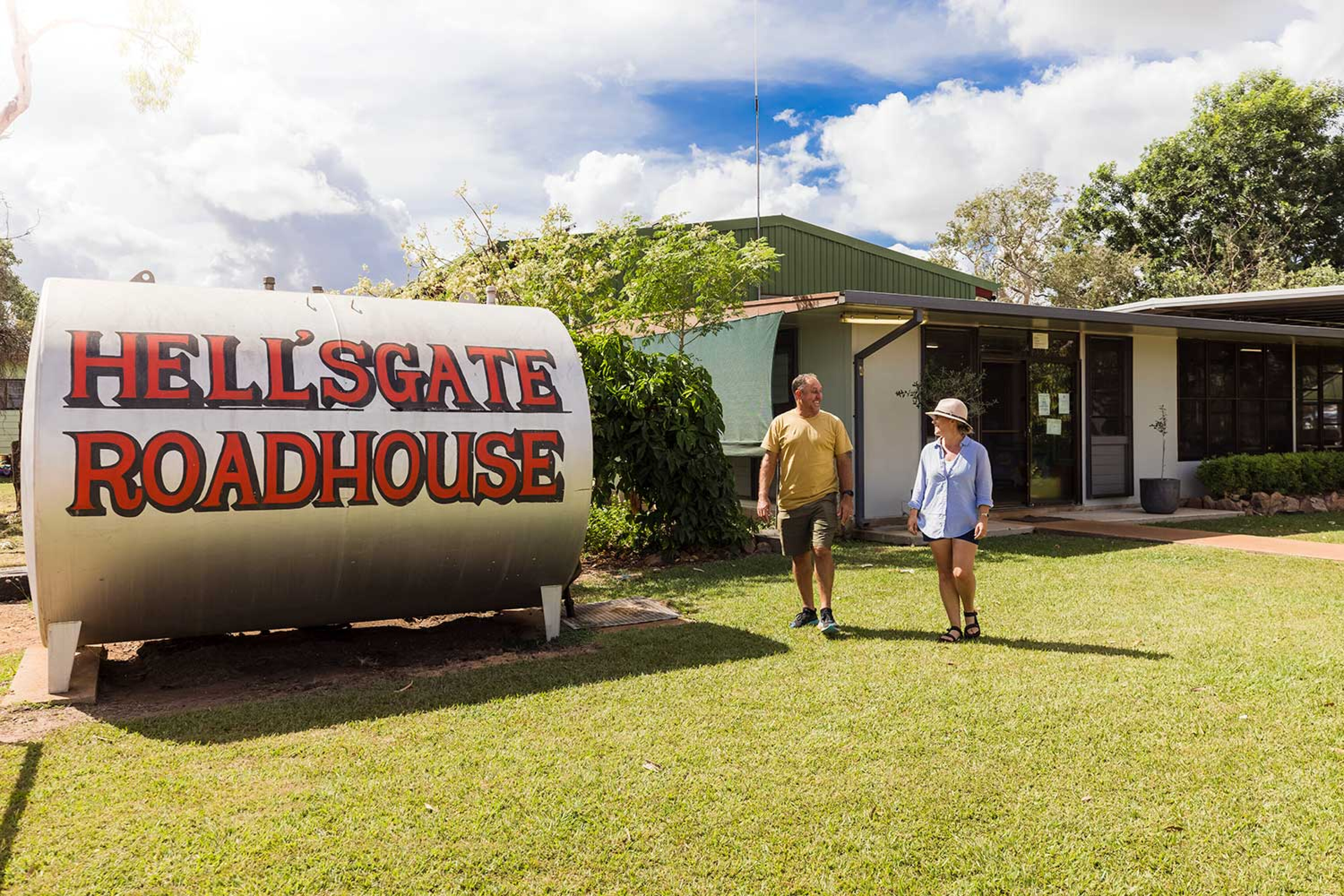
(See our Top 5 4WD Road Trip Tips at the end of this yarn to make sure you’re fully prepared for a memorable adventure.)
Perhaps ironically, it is at Hell’s Gate Roadhouse, just east of the NT/QLD border, that the North Queensland leg of the Savannah Way begins. Belying its name, this roadhouse offers top nosh and brilliant hospitality – an ideal way to start the journey east to Cairns.
From the vast grassy plains of the west, through rugged gorge country, and then on to the volcanic landscape near the Atherton Tablelands, before dropping down to the coast, this journey takes you and your crew through a wide variety of landscapes.
Among the many highlights of this adventure, Boodjamulla (Lawn Hill) National Park and nearby Riversleigh (Miyumba) Fossil Fields are stand-outs and are part of your first stop, reached via an unsealed road south from Hell’s Gate.
The sandstone gorges in the national park are fed by freshwater springs (and rainfall) and make for brilliant water-borne exploration – something you would never think possible in the outback. Camp at Lawn Hill Gorge Camping Area (or Wugudaji-Adel’s Grove, 10km away, where you can opt for a campsite to set up the tent, or cabins). From here you can also join guided tours to the gorge (and/or the fossil fields) for a few days and explore it by canoe, kayak or SUP.
For touring families, time spent at the fossil fields is a no-brainer. The site provides a pathway back in time (around 25 million years), with the fields’ high concentration of mammal fossils, including that of a small relation to the Tassie Tiger, a carnivorous giant rat-kangaroo and – yep, it’s true – a tree-climbing crocodile.
For excitement of a different kind the following day, the trip to Burketown will reward both anglers (it’s considered Australia’s barramundi capital) and birdwatchers, with the town bordered by both wetlands and grasslands, rich with Aussie birdlife.
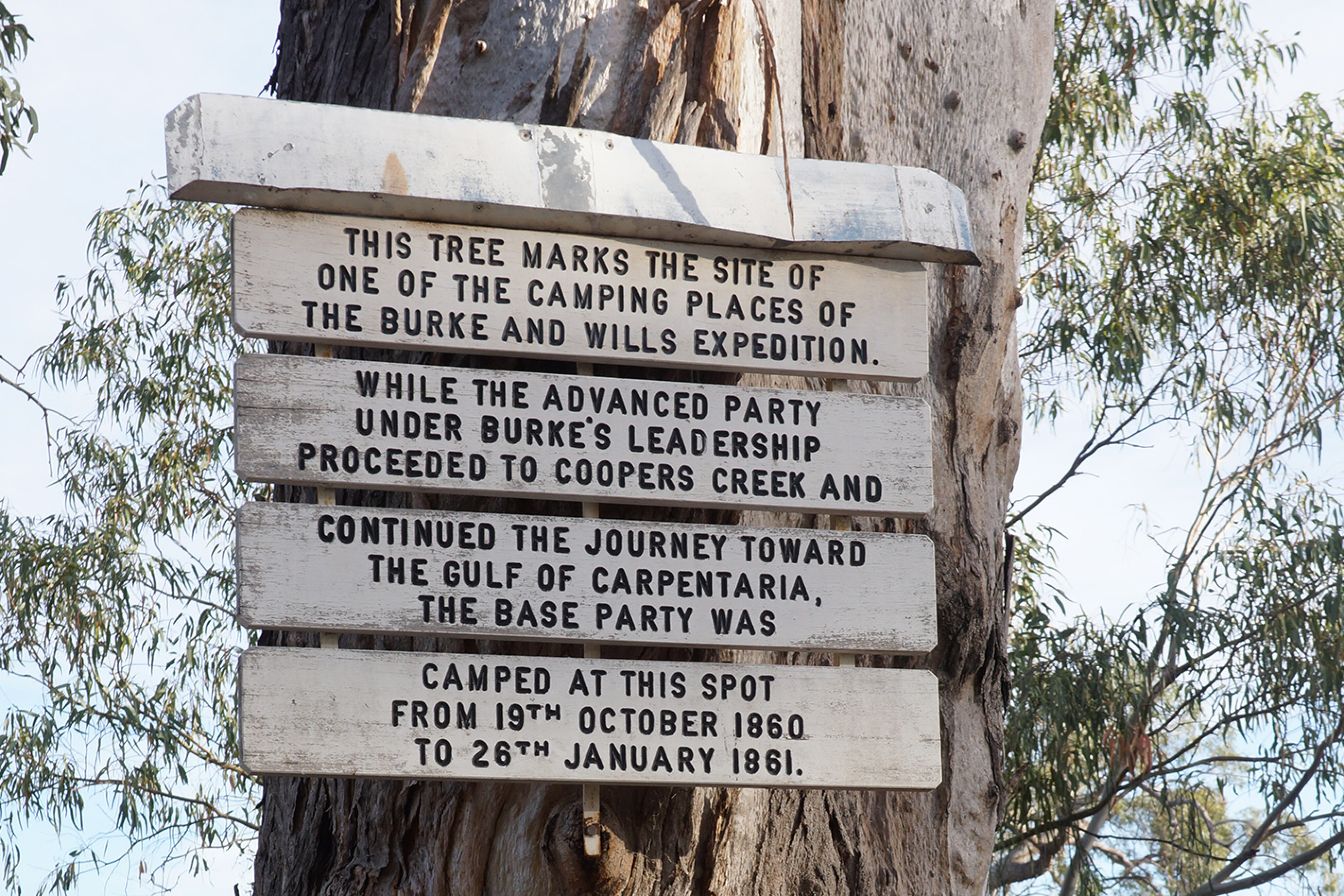
Be sure to throw a line in for that elusive barra and, if you’re there in spring, get up early to witness the famous morning glory clouds, a low-lying cloud formation that, literally, rolls into town from the coast. Burketown deserves at least a few days, for not only those activities, but a few others, such as hearing the Gangalidda People’s Dreamtime stories interpreted through star-gazing with Yagurli Tours.
If you fancy getting up close and personal with a gigantic saltwater crocodile, head to Normanton, around two hours from Burketown. Here, you’ll find a replica of what is claimed to be the largest croc ever captured, as well as some cracking local pubs. For history buffs, a monument to Camp 119, the last campsite of the 1861 north-south Burke and Wills expedition, before they reached the Gulf of Carpentaria, can be found near the banks of the Little Bynoe River.
And that croc? Well, at 8.63 metres in length ‘Krys’ (named after Krystina Pawlowski, the woman who shot it, in 1957.) is immortalised as a life-size statue in the middle of town – and yeah, it makes for a cracking selfie.
For lovers of train travel, be sure to schedule in an extra day to jump on board The Gulflander and enjoy the train guides’ stories of the gold rush in nearby Croydon, before returning via coach.
Georgetown is famous for its fossicking opportunities and is only an hour away from Croydon. It’s a great stop-over before reaching one of the Savannah Way’s other natural highlights: Cobbold Gorge.
Join a guided boat tour at the gorge or grab a paddle and head out on a stand-up paddleboard to get up close to this natural wonder. There’s also a helicopter flight over the gorge if you so wish. Spending a day or two here won’t disappoint. From the gorge, heading northward takes you to Talaroo Hot Springs and then, the following day, you reach the amazing Undara Volcanic National Park.
The drive to Undara Experience is easy, and this awesome bush accommodation site makes a brilliant base-camp for a few days’ exploration of the nearby Undara Lava Tubes, the world’s longest lava flows, estimated to be roughly 190,000 years old. The national park has some great short walks (a sunset walk around Kalkani Crater is a cracker) and going down into the tubes on a guided tour is brilliant.
More hot springs follow as you drive the well-graded dirt roads eastward from Undara, with Innot Hot Springs a nice stop-over before the landscape changes again as you move closer to Atherton Tablelands. For those with time, a side-trip to Chillagoe-Mungana Caves National Park allows you to explore some of these deep caves on a ranger-guided or self-guided tour.
The green, rolling hills of the Atherton Tablelands, combined with a proliferation of waterfalls, provide the transformation from outback to hinterland as you arrive at Atherton itself. The Waterfall Circuit is a must-do, starting from the town itself, or you can enjoy this region’s sumptuous food trail. For the more active, there are short walks to waterfalls or, for two-wheel fans, the famous Atherton Forest Mountain Bike Park, with trails for all rider levels.
A couple of days (or even a week) in Atherton is a nice way to enjoy this next-to-last stop on the Savannah Way, with Cairns, just ‘down the hill’ from Atherton, and the gateway to the Great Barrier Reef, the end-point of this road-trip epic.
It’s well worth noting that a few days spent in Cairns itself is fun and rewarding. The Cairns Aquarium is fantastic, with 71 exhibits that feature 10 different ecosystems. You can also dive with sharks here or check out the Aquarium’s turtle hospital.
Cairns is also a foody’s delight, with many seafood restaurants and the must-visit Rusty’s Markets, where you’ll find plenty of local produce. Add in a morning run along the Cairns Esplanande, or some short walks through the Cairns Botanic Gardens and you can easily while away a few days here. Of course, also here you can join trips to the reef or nearby islands, such as Green and Fitzroy.
The Savannah Way rightly holds a place as one of Australia’s premier road trips and this North Queensland leg definitely contains enough natural highlights and enjoyable driving to keep you ‘up north’ for far longer than you may have originally planned – and that’s gotta be a good thing.
For more, see drivenorthqueensland.com.au [↗]
Overlanders Way
North Queensland’s other big-bopper road trip is the mighty Overlanders Way, travelling 1097km from the coastal city of Townsville, and the Great Barrier Reef, through gold mining towns, rugged gorges, dinosaur country, and then into the red dirt and blue skies of spectacular Outback Queensland.
This big road trip is long but a relatively easy drive, best suited to a prepared 4WD. It is best kicked off with a day in Townsville itself (check out the Reef or visit Reef HQ Aquarium and its Turtle Hospital) before heading to Charters Towers, one of Australia’s most famous old gold mining cities, where you can tag along on a Ghosts of Gold Heritage Tour or check out the city’s historic centre and goldrush-era buildings.
Dinosaur nuts will love Hughenden, your next stop, where close to 3000 dinosaur and marine fossils (this area was once an inland sea) have been found and where the excellent Flinders Discovery Centre is located. You can also check out a life-size replica of the first complete dino skeleton found in Australia.
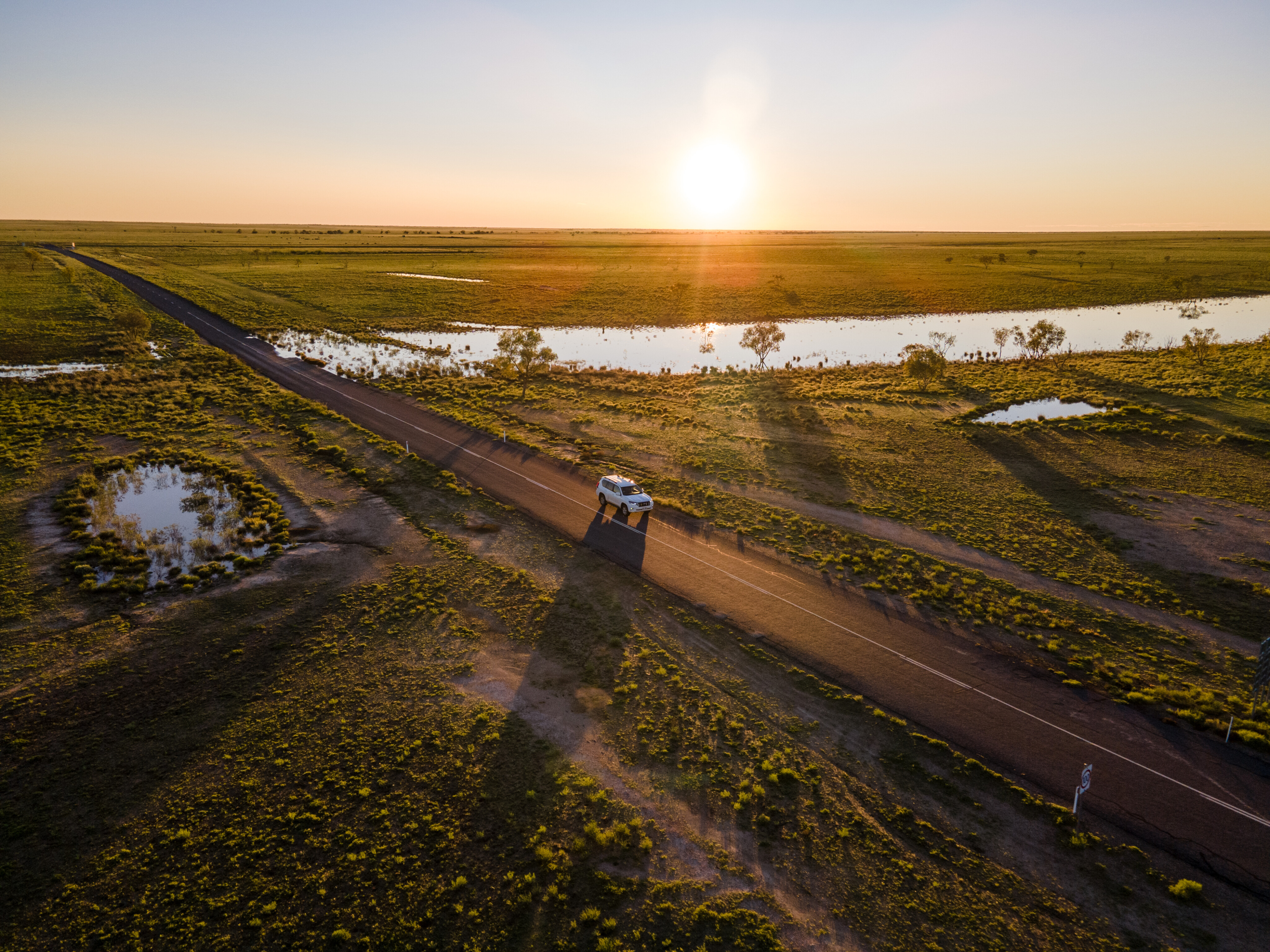
An hour’s easy drive north of Hughenden, on the way to Richmond (another dinosaur hot-spot and regarded as Australia’s ‘dinosaur capital’), make sure you stop and check out Porcupine Gorge National Park. This park’s creeks, huge cliffs and lush vegetation are an incredible contrast to the region’s much drier surrounding landscape.
Once at Richmond, head straight to Kronosaurus Korner, where you will find more than 1150 fossil specimens. You can also do some fossicking at the fossil site. For those visiting in warmer weather, Lake Fred Tritton is worth a stop-over (or paddle spot; if you have a canoe). If you’re keen, throw a line in and you may snag a barra for lunch (the lake has free barbecue facilities).
The westward journey continues, firstly to Julia Creek (check out the ‘At The Creek’ visitor’s centre, you will get the chance to view the very rare Julia Creek dunnart in a cool nocturnal viewing area), and then on to the birthplace of the famous Royal Flying Doctor Service (RFDS) where the Reverend John Flynn first came up with the RFDS concept. The museum and art gallery dedicated to Flynn are both found in Cloncurry.
More pioneer history can be found at the town’s Mary Kathleen Memorial Park & Museum, which is home to a keepsake (a drink bottle) of the explorer who named the town – Robert O’Hara Burke – as well as providing plenty of info for visitors about the abandoned Mary Kathleen uranium mine.
The leg from Cloncurry to Mount Isa is scenic, taking you through the rugged mountains of the Selwyn Range, where gold and copper were discovered, back in the late 1880s. Make sure you take the dirt road side-track to Fountain Springs waterhole along the way. From here, there is the 4WD-only Ballara Mining Heritage Trail. It’s a more challenging drive, but a well set-up 4WD will provide the chance to check out a couple of old mine towns along it.
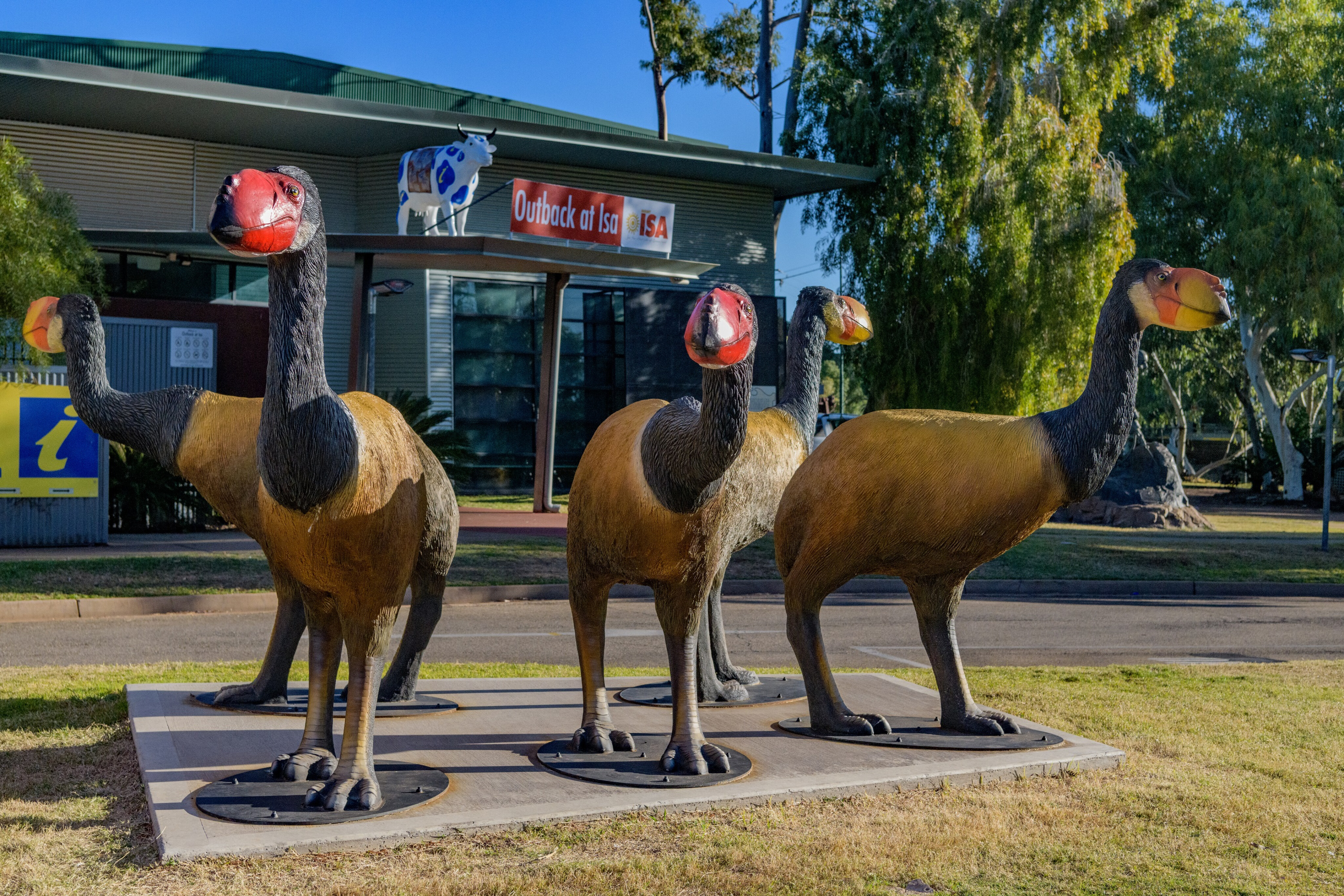
Mount Isa is Outback Queensland’s only city, with a wide range of facilities, restaurants/cafes and things to explore. To that end, you’ll find plenty of memorable experiences here, such as a tour of the underground Hard Times Mine, located in the Outback at Isa Visitor Centre. Here, you’ll drop down 22 metres below the ground to see what a miner’s life was like.
For those ever-keen dinosaur hunters, the nearby Riversleigh Fossil Centre (also at Outback at Isa) showcases some of the fossils dug up at the nearby fossil fields. For 4WD tourers, there are a number of tracks to explore just out of town, too, with the trek to the old town of Mary Kathleen a great half-day jaunt and allows you to explore not only the historic town, but the old mine pit as well.
Australia’s School of the Air has a base at Isa, so duck in to check out how kids in remote areas and properties learn – it’s impressive. Other highlights for history buffs include the World War II underground hospital and also the last surviving ‘tent house’. This abode was built for miners back in 1937 and has been preserved to show the style of accommodation those early workers resided in. It’s great.
The mighty Overlanders Way ends 188 kilometres west of Mount Isa, at Camooweal, known as the ‘Gateway to the NT/Queensland’. There is a Drovers’ Camp Museum here, which is a great source of information about the town’s droving history, while just out of town is the amazing Camooweal Caves National Park, with its many sink-holes and caves estimated to be up to 500 million years old. For keen ‘spelunkers’ (that’s ‘cavers’ for the rest of us), it’s a must-explore destination. Uniquely, now that Camooweal is considered a suburb of Mount Isa, the Barkly Highway that links the two is claimed to be the world’s longest main street.
For more, see drivenorthqueensland.com.au [↗]
North Queensland Wildlife Tracker
For fans of Australia’s unique wildlife, North Queensland is the ultimate destination for a wild driving adventure. Whether it’s a koala, wallaby, platypus, saltwater croc, the majestic brolga or the towering cassowary, you will be more than spoilt for choice on this 300km sojourn from Ayr to Hinchinbrook Island.
This route is suitable for all vehicles, and is an easy, relaxed drive, allowing you to take in the gobsmacking surroundings as you explore the region.
The townships of Ayr and Home Hill are located in agricultural country, aptly titled the sugar cane capital of Australia, and it's this food bowl of fresh fruit, vegetables and sugarcane fields that makes it the ideal place to stock up on fresh produce for this road trip! This area is part of the Burdekin River delta, with the wetlands home to 44 mammal species, 250 bird species and 51 species of reptiles. At the 1600-hectare Cromarty Wetlands, you will spot magpie geese, brolga, and more.

For advanced divers, the SS Yongala, at Alva Beach, Ayr, is a no-brainer. Touted as one of the world’s best diving sites, this shipwreck dive will have you swimming amongst mega marine fauna including giant trevally, Queensland groper, moray eel, and a variety of ray and turtle species. If you want to stay dry, a visit to the Ayr Nature Display will have you up close and personal to creatures of a very different scale - with a mosaic of critters on show - including beetles, butterflies and other unique North Queensland crawlies.
It’s only a bit more than an hour’s drive north from Ayr to Townsville where, again, you’ll be overwhelmed by the variety of native wildlife, conservation parks and surrounding natural environments, offering no shortage of potential wildlife encounters. The city’s famous Town Common Conservation Park, and Cape Pallarenda Conservation Park are criss-crossed with walking tracks and mountain bike trails that provide (seasonal) viewing of brolga flocks, magpie geese, wallabies and more.
While these places are abundant in all manner of quintessential native animals, a sure way to meet Australian fauna is at the iconic Billabong Sanctuary, a wildlife park home to creatures big and small including koalas, dingoes, wombats, cassowaries and even mainland Queensland’s largest captive saltwater croc – Krakatoa (5.1m).
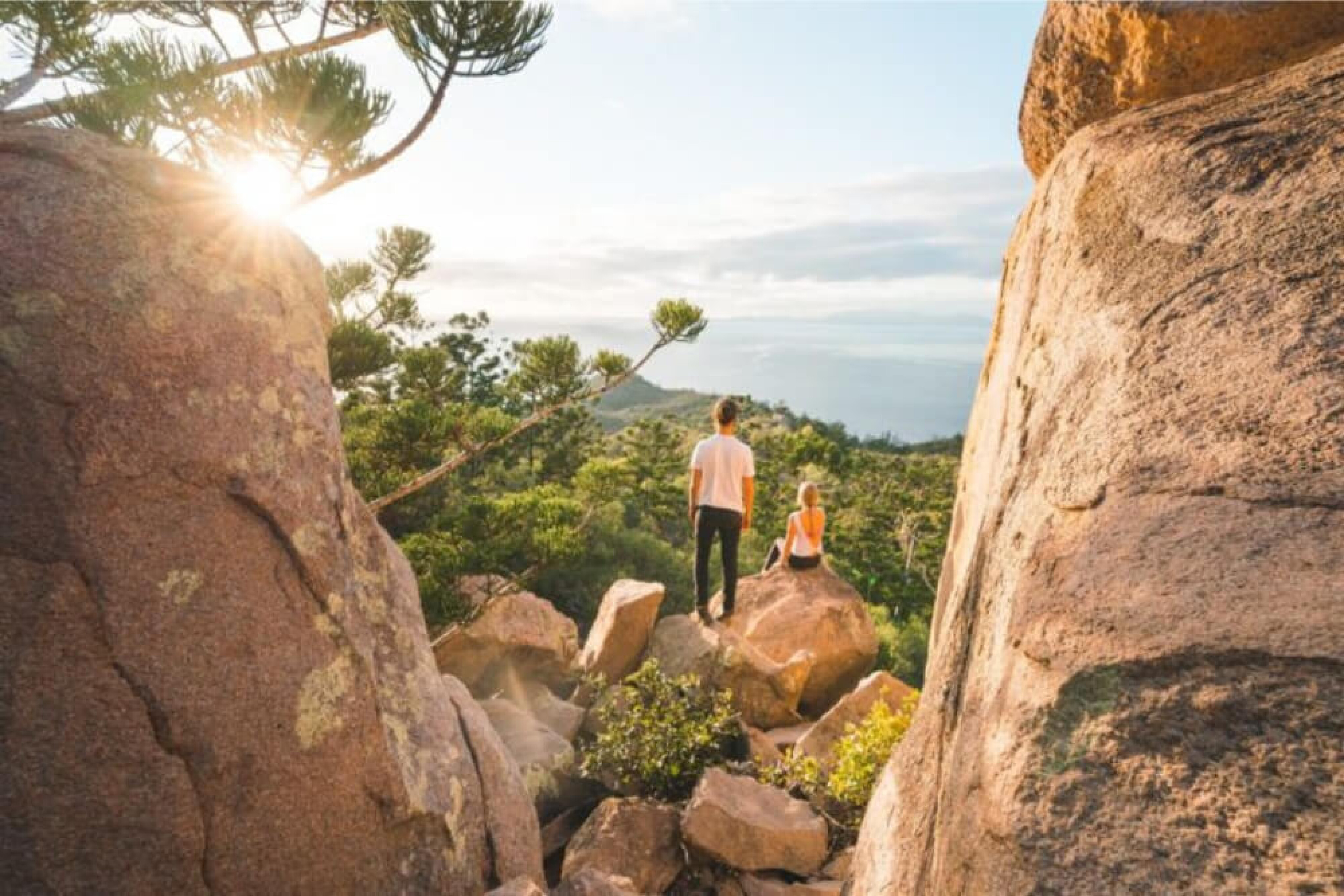
Jump aboard a ferry to nearby Magnetic Island National Park where, again, you’ll have no trouble spotting native wildlife, from photogenic rock wallabies to the largest colony of wild koalas in Australia’s north, or (from May to August) experience the butterfly walk - a flock of migratory Blue Tiger butterflies - along a pretty paperbark forest walk in Horseshoe Bay.
The National Park island is worth at least a couple of days of exploration, with 23 beaches and bays and the chance to go snorkelling along fringing coral reef (there are two self-guided snorkel trails, and a number of operators offering guided snorkel tours), and a direct launchpad to the central section of the Great Barrier Reef, before chilling out at sunset on the beach (or a sailboat).
The island is not a 4WD destination as such, but you will need your tourer for the short track out to West Point, thanks to a couple of creek crossings. It's worth the short diversion, though, both for the drive and the uninterrupted sunset views.
For a truly unique North Queensland wildlife experience (it’s hard to find just one here; there are so many to choose from) you can’t go past a trip out to Hinchinbrook Island, north of Townsville, and off the coast of Ingham. And that ‘truly unique’ experience?
Well, that’d be the trip by boat (or sea kayak) across to the island; travelling through the Hinchinbrook Channel, there’s a chance of spotting the very shy dugong feeding among the channel’s sea grass beds, or fish to catch the almighty barramundi. Matched with spotting one of the island’s other, more prolific native residents: the beautiful cassowary, this National Park island – the biggest in the Great Barrier Reef Marine Park is a special place.
Partnered with the mainland counterpart in Girringun National Park - home to Australia’s tallest waterfall – the Hinchinbrook region is a nature-lover (and wildlife tracker) paradise.
For a relatively short road-trip, this wildlife-focused journey has to rank as one of the world’s best, for not only the pleasant drive experience itself, but the sheer volume of wildlife and birdlife you have the chance to observe during it.
For more, see drivenorthqueensland.com.au [↗]
Adventures in The Whitsundays
The Whitsundays region is the epitome of wild natural beauty, with the 74 island wonders being an iconic bucket list experience. However, look past the islands’ pristine beaches and fringing Great Barrier Reef, and you will find The Whitsundays mainland. An equally amazing part of this region, and one ripe for an exploratory road trip that, thanks to the easy access via sealed roads to most attractions, means your 4WD can take it easy. This is how you do it…
The Whitsundays hinterland is home to Conway National Park and the beautiful Cedar Creek Falls, our start-point for this 194km road trip, accessed via Conway and Saltwater Creek roads. If you’re at the waterfall in the wet season, you’ll see it in full flow, but even when not, the year-round swimming hole at its base is worth the drive.
You can even explore the smaller rock pools higher up, thanks to tracks that lead to the top of the waterfall. It’s an invigorating way to start a road trip.
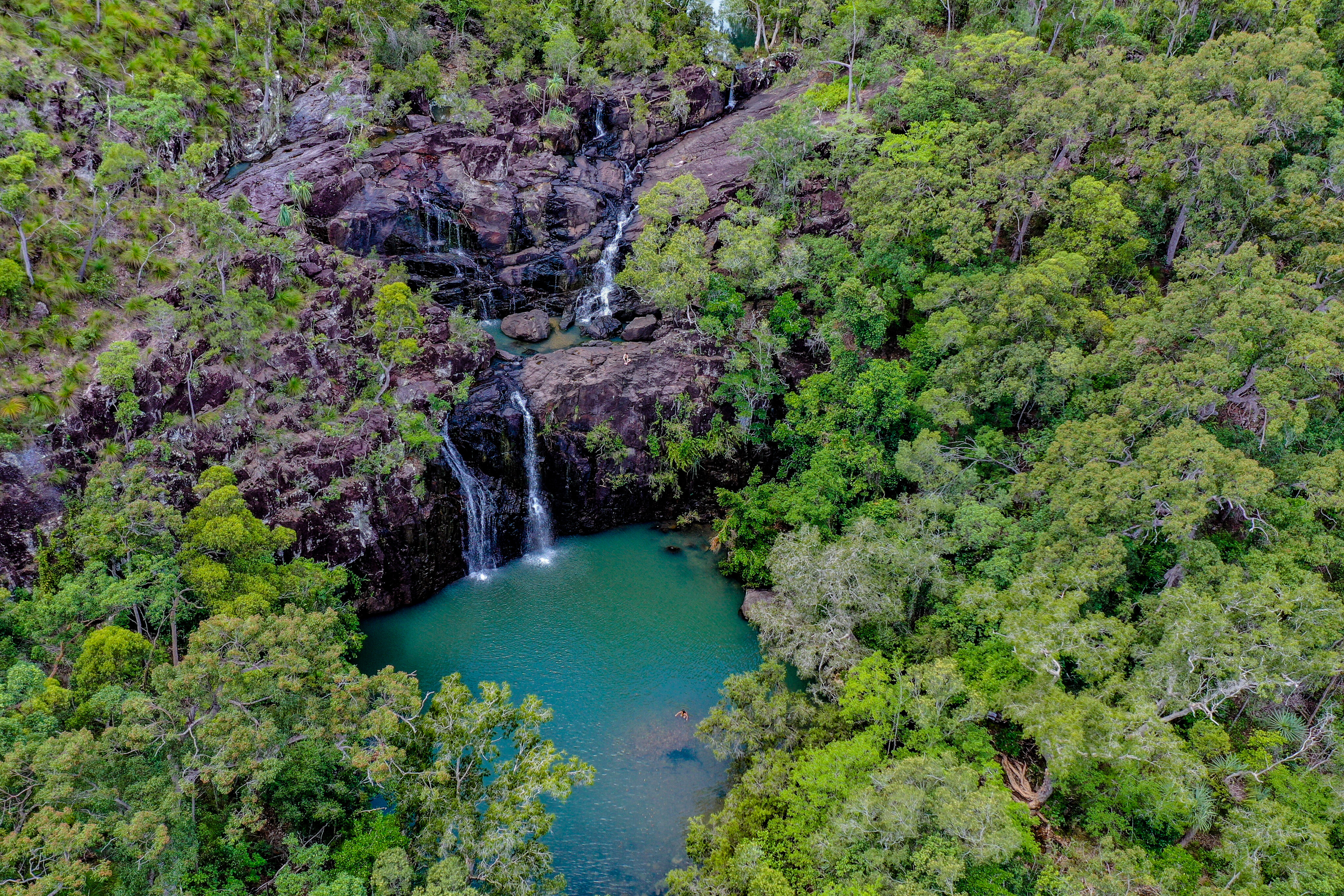
When it comes to locals’ favourites, it’s hard to beat the gorgeous Hydeaway Bay [↗] and surrounding beaches, 45 minutes’ drive north of Airlie Beach. The 2km beach has a number of access points and is perfect for strolling along the sand at sunset, checking out the rocky outcrops that dot the coast and encouraging the kids to find some cool seashells.
Tip: If you’re travelling with your furry friends, Hydeaway Bay has a designated dog off-leash area, perfect for letting them run wild.
Next, make your way south from this heavenly piece of coastline to The Whitsundays’ mainland hub, Airlie Beach [↗]. Here, you can book a number of hinterland and island-based activities, such as hikes or boat trips out to the islands and Great Barrier Reef, as well as enjoy top-notch dining, swimming in the Coral Sea (or even the Airlie Beach Lagoon) and buying up big at the local markets each Saturday.
Nestled behind Airlie Beach, the rainforest-covered mountains are home to some incredible walking tracks. One of the highlights is the challenging but oh-so-worthwhile 2.5-hour climb to Honeyeater Lookout (you’ll cop an all-encompassing view of Airlie Beach and The Whitsunday Islandsfrom here). While you’re heading uphill, don’t forget to look up and around – this walking track offers fine birdwatching.
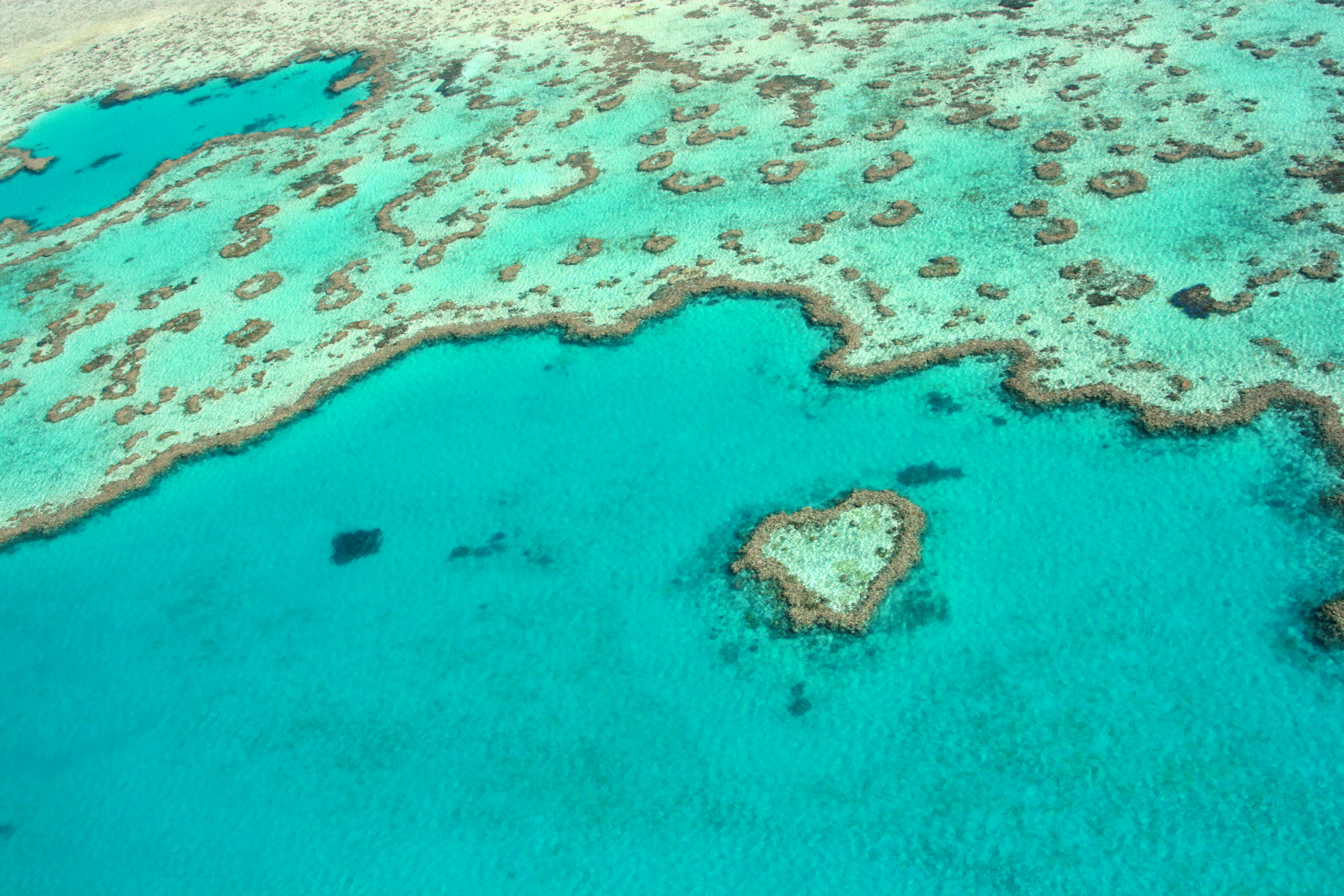
After enjoying Airlie Beach’s many delights for a day or two, the final leg of this road trip is a short jump north, to Bowen [↗], the mango capital of Australia and home to – you guessed it – the Bowen Mango (also known as the Kensington Pride) as well as the iconic Big Mango – a prime selfie opportunity.
Of course, it’s not only the sublime mangoes that are responsible for Bowen’s fame as a must-visit part of The Whitsundays; the town’s many secluded beaches are (each and every one) are worth spending time at. Horseshoe Bay is a great option for those keen on a swim, picnic or some exploratory snorkelling (you can hire snorkelling gear in town).
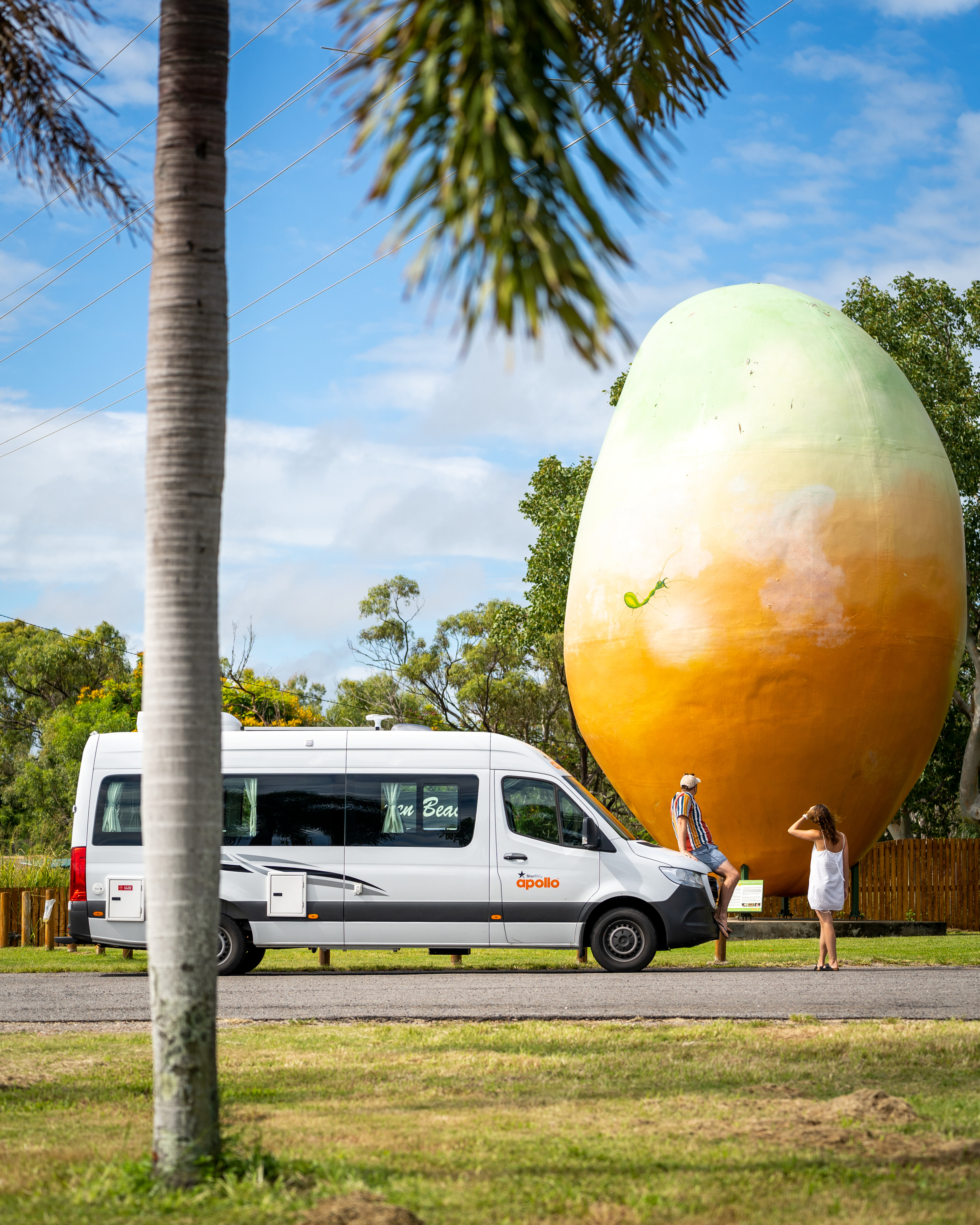
In fact, this is one of the few locations where you can snorkel the fringing Great Barrier Reef straight off the beach. And, after that breathtaking experience, be sure to visit Flagstaff Hill, where you will experience even more amazing views across this area’s bays and beaches.
There’s no more fitting way to finish off a road trip in The Whitsundays than to tuck into some of Bowen’s famous fresh seafood. The seafood at Bird's Fish Bar, at Bowen Fishermans Seafood Co, is unloaded from the boats each day and cooked to order, with handy outdoor seating nearby. Yep, like we said, it’s most fitting!
For more, see drivenorthqueensland.com.au [↗]
The Mining Trail
The Mackay Isaac region is the perfect location for an adventurous North Queensland road trip. From camping in old gold towns and paddling in huge lakes, to enjoying a historic watering hole and chasing the elusive barramundi, this part of North Queensland will keep you entertained for a week or more. This route is, again, relatively easy in terms of driving, with either an SUV or a 4WD more than suitable.
Starting at the regional hub of Mackay, on the coast, this 500km road trip meanders southwest, via Nebo, before turning slightly north-east for another half an hour or so to reach the first stop on this itinerary: the former (and long since abandoned) gold mining town of Mt Britton.

After being founded in 1880, through its halcyon gold rush days, where it grew to include a number of pubs, hotels and 1500 people, until the gold dried out less than 10 years later, the town dwindled and then was abandoned. There are many examples of mining equipment still here, along with information signage relating to the town and mine’s short history, and a lookout.
You can camp here, too, and experience the town's ‘spooky’ reputation enjoying a beautiful North Queensland sunset and star-filled night sky. There is also more camping at nearby Moonlight Dam, inside Homevale National Park. This camping area also offers good birdwatching around dusk.
A short 77km further inland, you will find Lake Elphinstone which, again, offers fantastic camping, but is also popular with anglers (you can catch the elusive red claw crayfish here), birdwatchers, those who like to water ski (in one section of the lake only, and dependent on water levels), and paddlers – canoes and kayaks are brilliant for exploring this natural lake.
Leave Lake Elphinstone for the longest leg of this trail (281km) and head to Nebo to check out the town’s famous heritage-listed pub, which was built in 1862, and overlooks Nebo Creek. After checking out this watering hole, take a stroll to the nearby Nebo Museum, which contains the Mount Britton Collection of paintings that reveal early pioneer life, as well as some restored vehicles and other historic objects.
From Nebo, take a stop at Moranbah (one of Queensland’s youngest towns, and one with plenty of services) and tackle the easy 1km Federation Walk that takes you to the Big Red Rhino Bucket, a nod to the town’s mining industry. Leaving Moranbah, it’s time to continue on to Clermont, another town with a mining history, both in gold and copper. You will pass the Gemini Peaks, two volcanic formations, along the way. Another landscape standout is Wolfgang Peak, in The Peak Range National Park. Do yourself a favour and trek up to its summit for some brilliant views.
Theresa Creek Dam is the end of this road trip – and it’s an absolute belter for those looking to fish and camp. The dam holds plenty of golden perch (aka yellow-belly), barramundi and the delicious red claw crayfish. Grab a fishing permit from the kiosk at the dam and try your luck, before kicking back at your lakeside campsite and think back on your previous few days exploring this unique part of North Queensland.
Top 5 4x4 road trip tips
- Service and education: Before heading out on any road-trip, no matter how close to home or otherwise, get your vehicle serviced beforehand. Your mechanic will pick up any potential issues and advise you on any spare parts you should take or any essential modifications (such as new suspension, additional lighting or frontal protection) that may be needed to ensure your 4WD (and yourself) completes the trip safely.
In addition to making sure your 4WD is up to that big road trip, be sure you, as the driver, are as well. Attending a 4WD driver training course is a must; you will learn how capable your particular vehicle is and be far more confident in both its – and your own – capabilities when exploring remote areas. Topics usually covered include how to perform a vehicle recovery, water crossings, how to safely negotiate steep terrain, drive in sand, and more.
- Tyres: For off-road travel (dirt roads, fire tracks, etc.), we’d advise – at a minimum fitting All Terrain tyres of Light Truck (LT) construction to your 4WD. If the route you’re contemplating is particularly rugged, go for LT Mud Terrain tyres. Tyres of Light Truck construction feature a thicker and more aggressive (read: grippier) tread pattern than the highway terrain tyres that are standard fitment on most new 4WDs these days.
LT construction tyres will also include a stronger sidewall, which increases resistance to staking or puncturing – especially pertinent when travelling off-road and having to lower tyre pressures. Speaking of which…
- Air up, air down: A four-wheel drive vehicle can take you to some spectacular remote parts of Australia, via some often rough, and/or sandy, tracks. For optimum traction (and safety), you will need to learn to adjust tyre pressures to suit different terrain.
When driving on sand, for example, by lowering your tyre pressures, you subsequently increase the tyre’s ‘footprint’, i.e., more of the tyre is in contact with the sand, which enhances traction in these types of loose surfaces. A similar process applies for rocky terrain; lowering tyre pressures so that your tyre ‘folds over’ the rock, means the rock has less chance of puncturing the tyre, as it has conformed to the shape of the rock, rather than being too highly inflated and thus forcing the rock into the tyre, causing a puncture.
Oh, and remember to pack a portable air compressor. You will need this to reinflate your tyres to safe pressures once you are back on sealed roads.
- Pack properly, pack safely: It is all too tempting to just throw all your camping gear, luggage, recovery equipment, water containers and other road-trip paraphernalia into the back of your 4WD and then drive off – but please don’t. In the unfortunate case of an accident, any unsecured luggage or gear transforms into a potentially deadly missile for vehicle occupants.
By strapping down all your gear with ratchet straps (or ropes), you will ensure that everything stays still and secure in the back, while you and your fellow occupants stay safe up front.
- Safety first: Before you head off on your big adventure, leave a rough timeline or itinerary with family and/or friends. Make sure you pack reliable communications as well, whether that is a UHF radio or a satellite phone; a mobile phone will not have a signal in most remote (and even not so remote) parts of Australia.
If you don’t own a sat-phone, hire one – they are the most reliable form of remote area communications. If you’re travelling with more than one vehicle, adhere to ‘convoy procedure’ which is, in a nutshell, where you always maintain visual contact with the vehicle behind you – especially if turning onto another road.
And don’t crowd yourself and the other vehicle, either; keep at least a 100m gap between each to avoid rocks hitting the windscreen or dust kicked up from the vehicle in front obscuring your forward vision.

COMMENTS